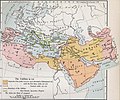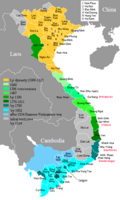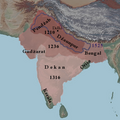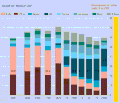Portal:Asia

 Asia (/ˈeɪʒə/ ⓘ AY-zhə, UK also /ˈeɪʃə/ AY-shə) is the largest continent in the world by both land area and population. It covers an area of more than 44 million square kilometres, about 30% of Earth's total land area and 8% of Earth's total surface area. The continent, which has long been home to the majority of the human population, was the site of many of the first civilisations. Its 4.7 billion people constitute roughly 60% of the world's population. Asia shares the landmass of Eurasia with Europe, and of Afro-Eurasia with both Europe and Africa. In general terms, it is bounded on the east by the Pacific Ocean, on the south by the Indian Ocean, and on the north by the Arctic Ocean. The border of Asia with Europe is a historical and cultural construct, as there is no clear physical and geographical separation between them. A commonly accepted division places Asia to the east of the Suez Canal separating it from Africa; and to the east of the Turkish straits, the Ural Mountains and Ural River, and to the south of the Caucasus Mountains and the Caspian and Black seas, separating it from Europe. Since the concept of Asia derives from the term for the eastern region from a European perspective, Asia is the remaining vast area of Eurasia minus Europe. Therefore, Asia is a region where various independent cultures coexist rather than sharing a single culture, and its boundary with Europe is somewhat arbitrary and has moved since its first conception in classical antiquity. The division of Eurasia into two continents reflects East–West cultural differences, some of which vary on a spectrum. (Full article...) Featured articleThe Javan rhinoceros (Rhinoceros sondaicus), Javan rhino, Sunda rhinoceros or lesser one-horned rhinoceros is a critically endangered member of the genus Rhinoceros, of the rhinoceros family Rhinocerotidae, and one of the five remaining extant rhinoceros species in South Asia and Africa. It has a plate-like skin with protective folds and is one of the smallest rhinoceros species with a body length of 3.1–3.2 m (10–10 ft) and a 1.4–1.7 m (4 ft 7 in – 5 ft 7 in) long tail. The heaviest specimens weigh around 2,300 kg (5,100 lb). Its horn is usually shorter than 25 cm (9.8 in). Up until the mid-19th to about the early 20th century, the Javan rhinoceros had ranged beyond the islands of Java and Sumatra and onto the mainland of Southeast Asia and Indochina, northwest into East India, Bhutan, and the south of China. Today, it is the rarest of all rhinoceros, and among the rarest of all living animal species, with only one currently known wild population, and no individuals successfully kept in captivity. It is among the rarest large mammals in the world with a population of approximately 74 rhinos within Ujung Kulon National Park, at the far western tip of Java, Indonesia. (Full article...) Selected Country Thailand, officially the Kingdom of Thailand and historically known as Siam (the official name until 1939), is a country in Southeast Asia on the Indochinese Peninsula. With a population of almost 66 million, it spans 513,115 square kilometres (198,115 sq mi). Thailand is bordered to the northwest by Myanmar, to the northeast and east by Laos, to the southeast by Cambodia, to the south by the Gulf of Thailand and Malaysia, and to the southwest by the Andaman Sea; it also shares maritime borders with Vietnam to the southeast and Indonesia and India to the southwest. Bangkok is the state capital and largest city. Thai peoples migrated from southwestern China to mainland Southeast Asia from the 6th to 11th centuries. Indianised kingdoms such as the Mon, Khmer Empire, and Malay states ruled the region, competing with Thai states such as the Kingdoms of Ngoenyang, Sukhothai, Lan Na, and Ayutthaya, which also rivalled each other. European contact began in 1511 with a Portuguese diplomatic mission to Ayutthaya, which became a regional power by the end of the 15th century. Ayutthaya reached its peak during the 18th century, until it was destroyed in the Burmese–Siamese War. King Taksin the Great quickly reunified the fragmented territory and established the short-lived Thonburi Kingdom (1767–1782), of which he was the only king. He was succeeded in 1782 by Phutthayotfa Chulalok (Rama I), the first monarch of the current Chakri dynasty. Throughout the era of Western imperialism in Asia, Siam remained the only state in the region to avoid colonisation by foreign powers, although it was often forced to make territorial trade and legal concessions in unequal treaties. The Siamese system of government was centralised and transformed into a modern unitary absolute monarchy during the 1868–1910 reign of Chulalongkorn (Rama V). In World War I, Siam sided with the Allies, a political decision made in order to amend the unequal treaties. Following a bloodless revolution in 1932, it became a constitutional monarchy and changed its official name to Thailand, becoming an ally of Japan in World War II. In the late 1950s, a military coup under Sarit Thanarat revived the monarchy's historically influential role in politics. During the Cold War, Thailand became a major non-NATO ally of the United States and played an anti-communist role in the region as a member of SEATO, which was disbanded in 1977. (Full article...) Featured biographyPreity G. Zinta (pronounced [ˈpriːt̪i ˈzɪɳʈa]; born 31 January 1975) is an Indian actress primarily known for her work in Hindi films. After graduating with degrees in English honours and criminal psychology, Zinta made her acting debut in Dil Se.. in 1998, followed by a role in Soldier in the same year. These performances earned her the Filmfare Award for Best Female Debut, and she was later recognised for her role as a teenage single mother in Kya Kehna (2000). She established a career as a leading Hindi film actress of the decade with a variety of character types. Her roles, often deemed culturally defiant, along with her unconventional screen persona won her recognition and several accolades. Following critically appreciated roles in Chori Chori Chupke Chupke (2001), Dil Chahta Hai (2001), Dil Hai Tumhaara (2002), and Armaan (2003), Zinta received the Filmfare Award for Best Actress for her performance in Kal Ho Naa Ho (2003). She starred in two consecutive annual top-grossing films in India, Koi... Mil Gaya (2003) and Veer-Zaara (2004), and was noted for her portrayal of independent, modern Indian women in Salaam Namaste (2005) and Kabhi Alvida Naa Kehna (2006), top-grossing productions in domestic and overseas markets. For her first international role in the Canadian drama Heaven on Earth (2008) she was awarded the Silver Hugo Award for Best Actress and nominated for the Genie Award for Best Actress. She followed this with a hiatus from acting work for several years, with intermittent appearances such as in her self-produced comeback film, Ishkq in Paris (2013), which failed to leave a mark. (Full article...) General imagesThe following are images from various Asia-related articles on Wikipedia. Featured picture Credit: Pratheepps The Toda people are a small pastoral tribe of less than 1,000 people who reside in the Nilgiri hills of Southern India. Shown here is a typical Toda hut, about 3 m (10 ft.) high, 5.5 m (18 ft.) long and 2.7 m (9 ft.) wide. They are built of bamboo fastened with rattan and thatched. The hut has only a tiny (about 0.9 x 0.9 m, 3 x 3 ft.) entrance at the front, which serves as protection from wild animals.
Did you know...
Updated: 21:05, 24 June 2025 In the news
Related portalsMajor Religions in Asia Middle East (West Asia) Central Asia and Caucasus Indian Subcontinent Southeast Asia East Asia Selected panorama
The Central Area of Singapore surrounded by the perimeter of five planning areas: the Marina Bay, the Downtown Core, Marina East, Marina South and Straits View. The area surrounding the bay itself, also called Marina Bay, is a 360 hectare extension to the adjacent CBD. It is also the new downtown of Singapore built on reclaimed land. TopicsCategoriesAssociated WikimediaThe following Wikimedia Foundation sister projects provide more on this subject:
More portalsShortcuts to this page: Asia portal • P:ASIA |






























































































